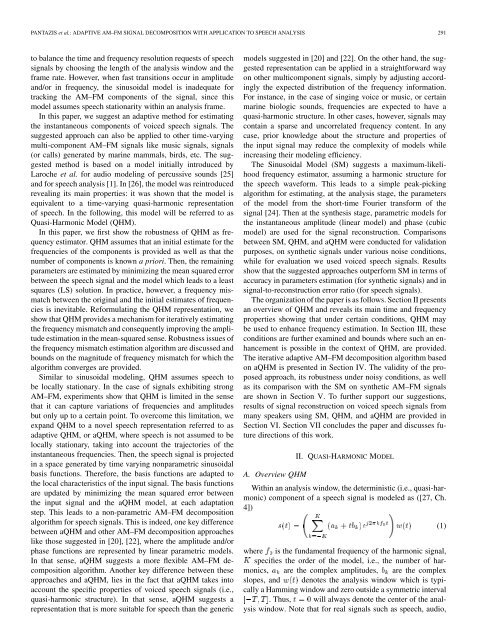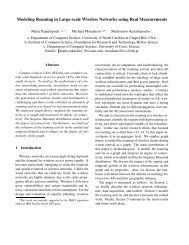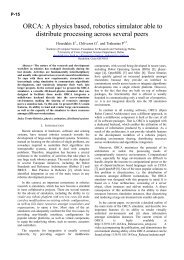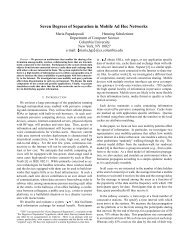Adaptive AM–FM Signal Decomposition With Application to ... - ICS
Adaptive AM–FM Signal Decomposition With Application to ... - ICS
Adaptive AM–FM Signal Decomposition With Application to ... - ICS
You also want an ePaper? Increase the reach of your titles
YUMPU automatically turns print PDFs into web optimized ePapers that Google loves.
PANTAZIS et al.: ADAPTIVE <strong>AM–FM</strong> SIGNAL DECOMPOSITION WITH APPLICATION TO SPEECH ANALYSIS 291<br />
<strong>to</strong> balance the time and frequency resolution requests of speech<br />
signals by choosing the length of the analysis window and the<br />
frame rate. However, when fast transitions occur in amplitude<br />
and/or in frequency, the sinusoidal model is inadequate for<br />
tracking the <strong>AM–FM</strong> components of the signal, since this<br />
model assumes speech stationarity within an analysis frame.<br />
In this paper, we suggest an adaptive method for estimating<br />
the instantaneous components of voiced speech signals. The<br />
suggested approach can also be applied <strong>to</strong> other time-varying<br />
multi-component <strong>AM–FM</strong> signals like music signals, signals<br />
(or calls) generated by marine mammals, birds, etc. The suggested<br />
method is based on a model initially introduced by<br />
Laroche et al. for audio modeling of percussive sounds [25]<br />
and for speech analysis [1]. In [26], the model was reintroduced<br />
revealing its main properties: it was shown that the model is<br />
equivalent <strong>to</strong> a time-varying quasi-harmonic representation<br />
of speech. In the following, this model will be referred <strong>to</strong> as<br />
Quasi-Harmonic Model (QHM).<br />
In this paper, we first show the robustness of QHM as frequency<br />
estima<strong>to</strong>r. QHM assumes that an initial estimate for the<br />
frequencies of the components is provided as well as that the<br />
number of components is known a priori. Then, the remaining<br />
parameters are estimated by minimizing the mean squared error<br />
between the speech signal and the model which leads <strong>to</strong> a least<br />
squares (LS) solution. In practice, however, a frequency mismatch<br />
between the original and the initial estimates of frequencies<br />
is inevitable. Reformulating the QHM representation, we<br />
show that QHM provides a mechanism for iteratively estimating<br />
the frequency mismatch and consequently improving the amplitude<br />
estimation in the mean-squared sense. Robustness issues of<br />
the frequency mismatch estimation algorithm are discussed and<br />
bounds on the magnitude of frequency mismatch for which the<br />
algorithm converges are provided.<br />
Similar <strong>to</strong> sinusoidal modeling, QHM assumes speech <strong>to</strong><br />
be locally stationary. In the case of signals exhibiting strong<br />
<strong>AM–FM</strong>, experiments show that QHM is limited in the sense<br />
that it can capture variations of frequencies and amplitudes<br />
but only up <strong>to</strong> a certain point. To overcome this limitation, we<br />
expand QHM <strong>to</strong> a novel speech representation referred <strong>to</strong> as<br />
adaptive QHM, or aQHM, where speech is not assumed <strong>to</strong> be<br />
locally stationary, taking in<strong>to</strong> account the trajec<strong>to</strong>ries of the<br />
instantaneous frequencies. Then, the speech signal is projected<br />
in a space generated by time varying nonparametric sinusoidal<br />
basis functions. Therefore, the basis functions are adapted <strong>to</strong><br />
the local characteristics of the input signal. The basis functions<br />
are updated by minimizing the mean squared error between<br />
the input signal and the aQHM model, at each adaptation<br />
step. This leads <strong>to</strong> a non-parametric <strong>AM–FM</strong> decomposition<br />
algorithm for speech signals. This is indeed, one key difference<br />
between aQHM and other <strong>AM–FM</strong> decomposition approaches<br />
like those suggested in [20], [22], where the amplitude and/or<br />
phase functions are represented by linear parametric models.<br />
In that sense, aQHM suggests a more flexible <strong>AM–FM</strong> decomposition<br />
algorithm. Another key difference between these<br />
approaches and aQHM, lies in the fact that aQHM takes in<strong>to</strong><br />
account the specific properties of voiced speech signals (i.e.,<br />
quasi-harmonic structure). In that sense, aQHM suggests a<br />
representation that is more suitable for speech than the generic<br />
models suggested in [20] and [22]. On the other hand, the suggested<br />
representation can be applied in a straightforward way<br />
on other multicomponent signals, simply by adjusting accordingly<br />
the expected distribution of the frequency information.<br />
For instance, in the case of singing voice or music, or certain<br />
marine biologic sounds, frequencies are expected <strong>to</strong> have a<br />
quasi-harmonic structure. In other cases, however, signals may<br />
contain a sparse and uncorrelated frequency content. In any<br />
case, prior knowledge about the structure and properties of<br />
the input signal may reduce the complexity of models while<br />
increasing their modeling efficiency.<br />
The Sinusoidal Model (SM) suggests a maximum-likelihood<br />
frequency estima<strong>to</strong>r, assuming a harmonic structure for<br />
the speech waveform. This leads <strong>to</strong> a simple peak-picking<br />
algorithm for estimating, at the analysis stage, the parameters<br />
of the model from the short-time Fourier transform of the<br />
signal [24]. Then at the synthesis stage, parametric models for<br />
the instantaneous amplitude (linear model) and phase (cubic<br />
model) are used for the signal reconstruction. Comparisons<br />
between SM, QHM, and aQHM were conducted for validation<br />
purposes, on synthetic signals under various noise conditions,<br />
while for evaluation we used voiced speech signals. Results<br />
show that the suggested approaches outperform SM in terms of<br />
accuracy in parameters estimation (for synthetic signals) and in<br />
signal-<strong>to</strong>-reconstruction error ratio (for speech signals).<br />
The organization of the paper is as follows. Section II presents<br />
an overview of QHM and reveals its main time and frequency<br />
properties showing that under certain conditions, QHM may<br />
be used <strong>to</strong> enhance frequency estimation. In Section III, these<br />
conditions are further examined and bounds where such an enhancement<br />
is possible in the context of QHM, are provided.<br />
The iterative adaptive <strong>AM–FM</strong> decomposition algorithm based<br />
on aQHM is presented in Section IV. The validity of the proposed<br />
approach, its robustness under noisy conditions, as well<br />
as its comparison with the SM on synthetic <strong>AM–FM</strong> signals<br />
are shown in Section V. To further support our suggestions,<br />
results of signal reconstruction on voiced speech signals from<br />
many speakers using SM, QHM, and aQHM are provided in<br />
Section VI. Section VII concludes the paper and discusses future<br />
directions of this work.<br />
II. QUASI-HARMONIC MODEL<br />
A. Overview QHM<br />
<strong>With</strong>in an analysis window, the deterministic (i.e., quasi-harmonic)<br />
component of a speech signal is modeled as ([27, Ch.<br />
4])<br />
where is the fundamental frequency of the harmonic signal,<br />
specifies the order of the model, i.e., the number of harmonics,<br />
are the complex amplitudes, are the complex<br />
slopes, and denotes the analysis window which is typically<br />
a Hamming window and zero outside a symmetric interval<br />
. Thus, will always denote the center of the analysis<br />
window. Note that for real signals such as speech, audio,<br />
(1)
















